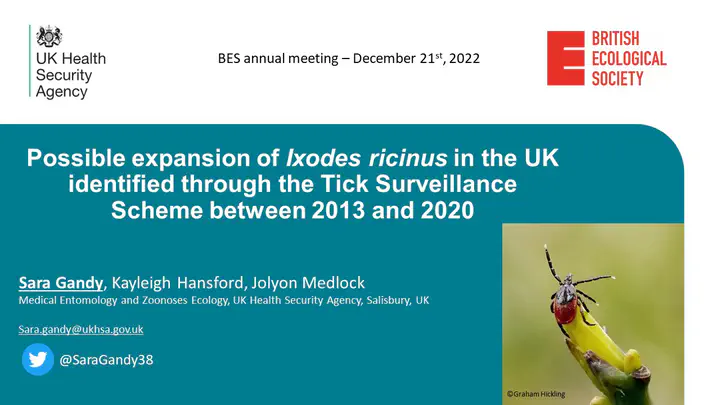Abstract
The tick Ixodes ricinus is the main vector of several pathogens including Borrelia burgdorferi s.l. and tick-borne encephalitis virus. Its distribution depends on many factors including suitable habitat, climate and presence of hosts. In this study, we present records of I. ricinus bites on humans, dogs and cats in the United Kingdom (UK) obtained through the Tick Surveillance Scheme between 2013 and 2020. We divided the UK into 20 km x 20 km grids and 9.2% (range 1.2%–30%) of grids had at least one record every year since 2013. Most regions reported a yearly increase in the percentage of grids reporting I. ricinus since 2013 and the highest changes occurred in the South and East England with 5%–6.7% of new grids reporting I. ricinus bites each year in areas that never reported ticks before. Spatiotemporal analyses suggested that, while all regions recorded I. ricinus in new areas every year, there was a yearly decline in the percentage of new areas covered, except for Scotland. We discuss potential drivers of tick expansion, including reforestation and increase in deer populations
Date
Dec 18, 2022 11:00 AM — Dec 21, 2022 5:00 PM
Location
Edinburgh ICC
Edinburgh,

Research Associate
My research primarily focuses on understanding the ecological drivers of tick-borne diseases to provide insights on the mechanisms involved in transmission cycles, especially on the interactions between ticks, hosts and pathogens. My research includes investigating the impacts of environmental changes (woodland restoration, rewilding) and host community composition (deer, rodent and birds) on tick-borne diseases risks in the UK. Some of my findings uncovered an opposing effect of deer densities on Lyme disease hazard through their positive effects on tick density and negative effects on infection prevalence. I also published work looking at spatiotemporal changes in tick distribution using passive surveillance data and I have been leading the National Tick Survey, which involves collaborating with stakeholders in thirty National Parks and recreational areas to collect ticks and test them for various tick-transmitted pathogens between 2021 and 2024. The goal is to understand disease hazard and temporal variation in areas visited by members of the public and deliver tick awareness messages.
